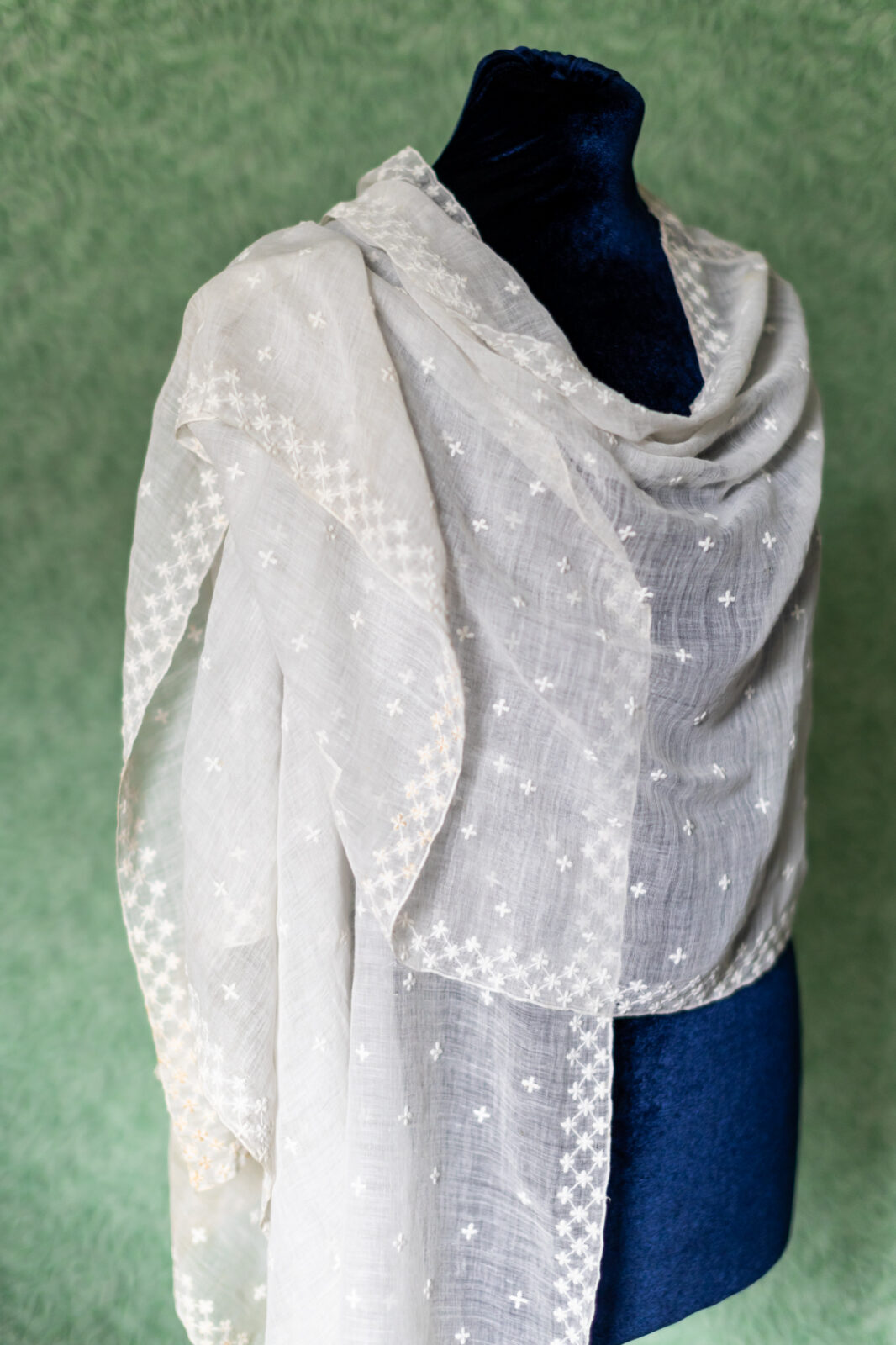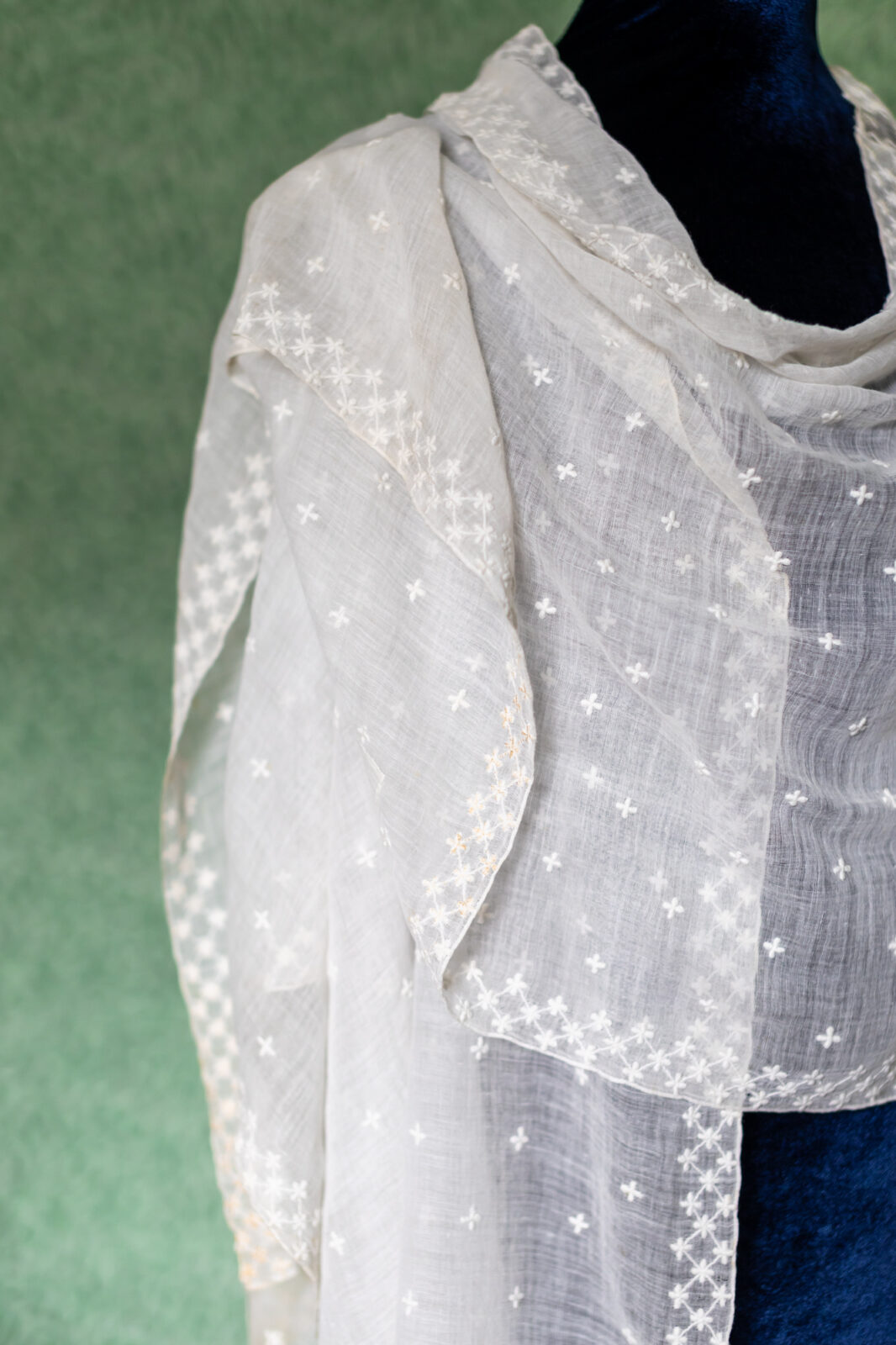Jane Austen’s Muslin Shawl: A Possible History
Our Reimagine Resident, poet Laboni Islam, has spent the last few months working on a series of poems inspired by Jane Austen's muslin shawl - an object she describes as 'a master key to the past'.Here we present Laboni’s series of seven poems, each one followed by an audio recording of Laboni reading it aloud.
We find this series of works incredibly beautiful and moving, and hope you love them as much as we do.
JANE AUSTEN’S SHAWL
Of muslin — two lengths, joined with lace.
A true Indian muslin, Mr. Tilney might say.
Spindle and loom
Spindle and loom —
cloth like the vapours of dawn,
the skin of the moon.
Jane moves between rooms
of the rectory, settles
by a casement window.
Over her small shoulders
drapes a muslin shawl.
Whose invisible hands
worked its warp and weft?
History has a high thread count.
Sometimes to understand the cloth
one must unravel the weave.
PHUTI KARPAS
— local name for Dhaka cotton
[EASTERN PART OF BENGAL, 18TH CENTURY]
It is June and my seeds
still wearing their wool
are sealed inside an earthen jar
smeared with ghee.
The jar hangs
from the roof of a raiyat’s hut,
above the place
hands kindle a fire.
This keeps
the rainy season’s damp at bay. Clouds
form a grey mood moving
over green. The rivers,
beels, jheels, and haors are brimming.
Kodom flowers
and feeds the bee.
Come November,
my seeds sown
along the Meghna’s banks,
will benefit
from soil’s vicinity to sea.
The sky will stir
my red stem’s creativity.
Few will see
my yellow flowers
fall, each cotton boll
burst open —
Famed far and wide
for my fine and silky fibres,
I desire only growth
and continuity.
SPINNING COTTON
[EASTERN PART OF BENGAL, 18TH CENTURY]
She wakes
before dew disappears —
wears a sari, drapes
its loose end over her head,
sits on a mat
with a bamboo work-basket
by her feet.
With one hand
she turns and turns
an iron spindle in the hollow of a shell.
With the other,
holds cotton
rolled around a lacquered reed
and wrapped with the skin of an eel.
As fibre twists to yarn,
she sees her spider-skill
drawn out —
She has cleaned the cotton
and combed its tangle
with the toothy jawbone of a boal —
a catfish that lurked
in the grassy margins of a muddy jheel.
On a board
made from the wood of a chalta tree,
she has rolled a pin
across the soft expanse,
separating fibre
from seed. Only then
did she pluck the catgut
of a bamboo bow,
blooming cotton
into a fleecy cloud.
This cotton will make fine muslin:
Spindle and loom
Spindle and loom —
cloth like the vapours of dawn,
the skin of the moon.
The spindle turns, the hours pass,
she avoids the noontime sun —
filaments of the day
cleaned
combed
ginned
bowed
spun.
WARP + WEFT
1775
[STEVENTON] Autumn — and fifteen miles from the Austen family home, a dozen swallows darted towards a hill. It was foggy. The leaves of a laden oak dripped till the ruts of a cartway ran with water. On December 16, Jane was born quickly with little warning. Winter arrived the same way — soon frost soon sleet soon snow filled the lanes and drifted up to the gate tops. Dhaka was five thousand miles away as the crow flies. Winds came from the west. A pleasant coolness in the air made punkahs stop flapping and fall still. Along the Meghna’s fertile banks, hardworking hands had reaped the rice, burned its stubble, ploughed the soil where cotton seeds were sown. The British East India Company controlled spindle and loom, spindle and loom — cloth like the vapours of dawn, the skin of the moon. Gomostas guarded weavers’ homes to thwart clandestine sales. Raiyats and weavers took advances below their cotton’s worth. And muslin shipped with spices carried the scent of cinnamon to its berth.
1799
[STEVENTON] From indoors, the weather was agreeable. Jane moved between rooms of the rectory, settled by a casement window with her companion — a portable writing-box made of mahogany. Gifted by her father for her nineteenth birthday, it held all her worldly wealth. She opened the box, and it became a desk. Hinges flew like fieldfares over its sloping surface. Muslin was on Jane’s mind. A shawl draped over her small shoulders, light as an untroubled conscience. Two lengths of muslin joined with lace — a true Indian muslin, Mr. Tilney might say. Jane charged her goose quill and turned to her writing. She possessed a talent for taking her thoughts and using them to furnish the minds of her characters. Jane wore her shawl frequently. Such was her attachment. Thus far, she congratulated herself on having preserved it from injury. When her shawl eroded, she would get enough out of it for a handkerchief, or a cap…Muslin can never be said to be wasted. Jane wrote speedily, not wanting her mind to snag on the details. Over a hundred miles away in Ancoats, an eight-storey steam-powered spinning mill was rising. Loom Street intersected with Bengal Street. In Dhaka, bee-eaters flew back and forth across the river, feeding on the wing.
ENDINGS
[CHAWTON / DHAKA, 1817]
Light visits
the dining parlour daily,
quiet as a quill
put down for the last time.
Was it the rook, the raven, or the crow that called
black as the cast iron grate
where Jane
made toast and tea?
A muslin shawl
without shoulders to warm adjusts
to a new economy.
No tariffs on light, only
on Indian cloth entering England,
whose machine-made yarn
and muslin
prepare to flood Bengal.
In Dhaka,
the British East India Company’s
cloth factory closes.
Weavers are weaving
in the arong —
they keep weaving
till their muslin disappears
like the vapours of dawn.
WEAVING
[DHAKA, 18TH CENTURY]
Light as a handful of rice
and carved from the wood of a betel palm,
the shuttle’s shape
is a squinting tiger’s eye.
It has taken days
to warp this bamboo loom.
The weaver sits close to the pit’s edge,
presses his left toe to a treadle —
warp strings rise
and fall on their heddles,
forming a shed
for threads of the weft.
The weaver welcomes humidity,
has mustard oil and lime water at the ready.
Around his waist
he wears a dhuti of coarser cloth
than the muslin he is making.
Spindle and loom
Spindle and loom —
cloth like the vapours of dawn,
the skin of the moon.
Known in Dhaka
but unnamed in history,
the weaver has patience
and a fine sensibility in his fingers.
With a flick of his wrist he
throws the tiger’s eye across the warp.
This has to do with time,
the shuttle flying back and forth.
Notes
In 1982, the spelling of “Dacca” changed to “Dhaka.” In these poems, “Dhaka” is used for all years.
“Jane Austen’s Shawl” includes the phrase “a true Indian muslin,” which is from Jane Austen’s novel Northanger Abbey. The phrase “vapours of dawn” is from a description of muslin by Yuan Chwang (602-664 CE), a Chinese traveller visiting India. The phrase “skin of the moon” is from a description of muslin by Abul Hasan Yaminuddin Khusrau (1253-1325 CE), an Indian poet. These phrases repeat in subsequent poems.
“Warp + Weft: 1799” includes the following phrases from Jane Austen’s novel Northanger Abbey:
…a true Indian muslin…
…congratulated herself on having preserved…from injury…
…get enough out of it for a handkerchief, or a cap…Muslin can never be said to be wasted…
Sources:
Allen, B.C. Eastern Bengal District Gazetteers: Dacca. Allahabad, The Pioneer Press, 1912. Internet Archive.
Austen, Jane. Northanger Abbey, 1803. Project Gutenberg.
Boyle, Laura. “Jane Austen’s China and the Steventon Archaeological Dig.” The Jane Austen Centre, 16 September 2015.
Davidson, Hilary. Dress in the Age of Jane Austen: Regency Fashion. Yale University Press, 2019.
Davidson, Hilary. Jane Austen’s Wardrobe. Yale University Press, 2023.
de la Pena, Clara. “Jane Austen’s Writing: A Technical Perspective.” The Morgan Library & Museum, 6 November 2009.
A Former Resident of Dacca. A Descriptive and Historical Account of the Cotton Manufacture of Dacca, in Bengal. London, John Mortimer, 1851. Internet Archive.
Hunter, W. W. A Statistical Account of Bengal, Volume 5: Districts of Dacca, Bákarganj, Parídpur, and Maimansinh. London, Trübner & Co., 1877. Internet Archive.
Islam, Khademul. “Our Story of Dhaka Muslin.” Aramco World, May/June 2016, pp. 26-33.
Islam, Saiful. Muslin. Our Story. Dhaka, Drik Picture Library Ltd., 2016.
“Jane Austen’s Birth, 16 December 1775.” Jane Austen’s House.
Legend of the Loom. Directed by Purabi Matin. Drik – Bengal Muslin, 2017.
Ng, H.H., de Alwis Goonatilake, S., Fernado, M. & Kotagama, O. “Wallago attu (errata version published in 2020).” IUCN Red List.
Rose, Michael E., Keith Falconer, and Julian Holder. Ancoats: Cradle of industrialisation. English Heritage, 2011. Historic England.
“A Timeline of Jane Austen’s Life and Works.” Jane Austen’s House.
“The Untold Story Of Jane Austen | Behind Closed Doors | Timeline.” YouTube, uploaded by Timeline – World History Documentaries, 31 December 2019.
Watt, George. A Dictionary of the Economic Products of India, Volume IV: Gossypium to Linociera. London, W.H. Allen & Co., 1890.
Watt, Sir George. The Wild and Cultivated Cotton Plants of the World: A Revision of the Genus Gossypium. London; Longmans, Green, and Co.;1907.
Welland, Freydis Jane. “The History of Jane Austen’s Writing Desk.” JASNA: Jane Austen Society of North America.
White, Gilbert. The Natural History of Selborne. Project Gutenberg.
White, Gilbert. “A Naturalist’s Journal, 1768-1793.” The Natural History of Selborne: journals of Gilbert White.
Woolsey, Sarah Chauncey. The Letters of Jane Austen, Selected from the Compilation of her Great Nephew Edward, Lord Bradbourne. Boston; Little, Brown, and Company; 1908. Project Gutenberg.


